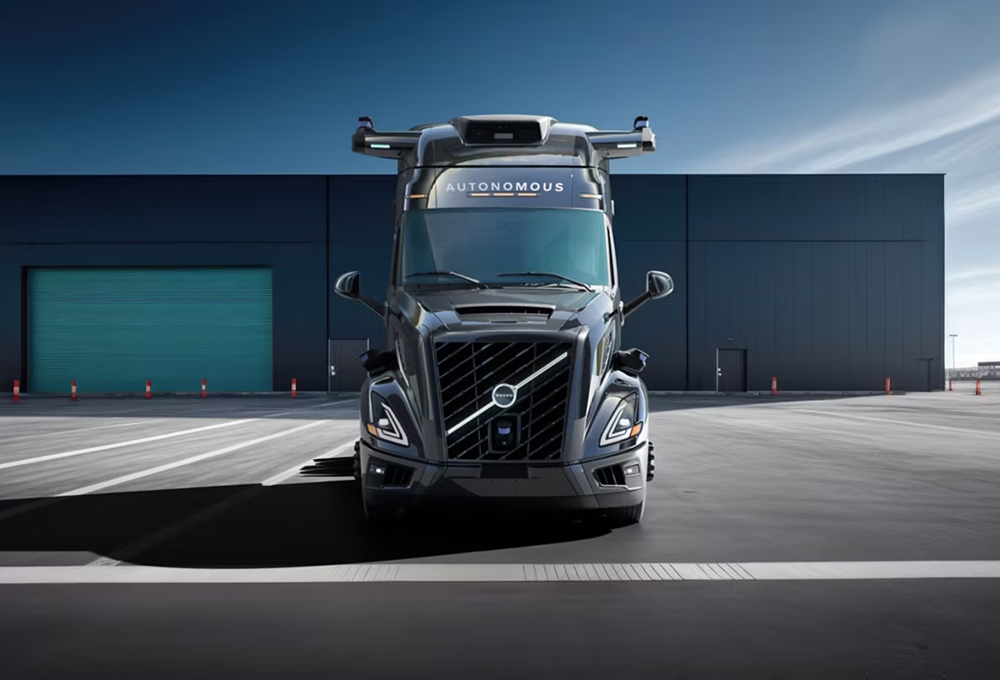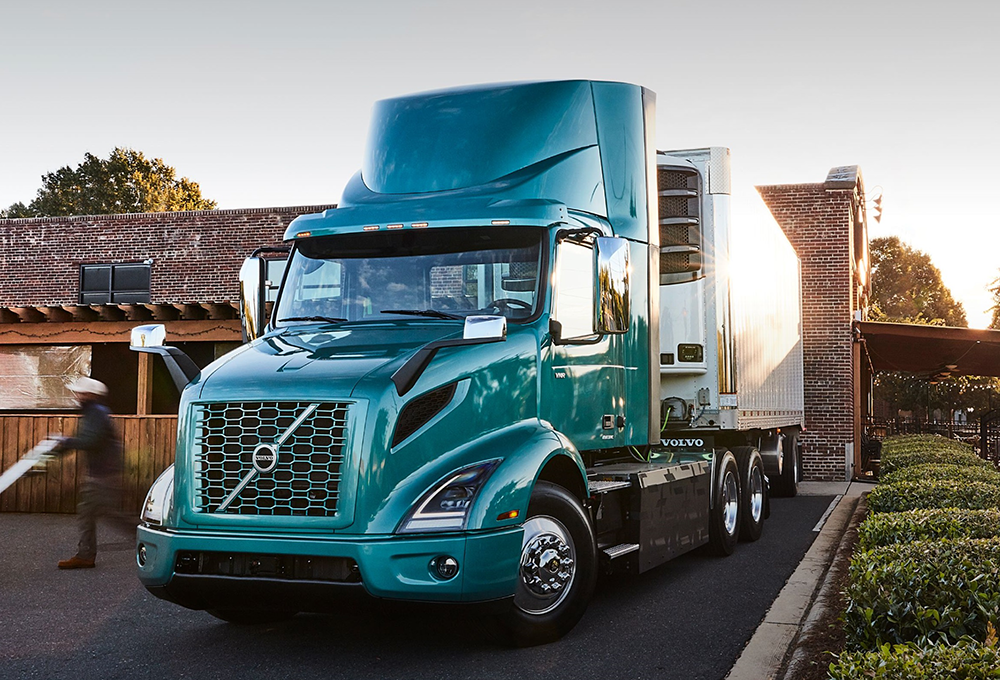 沃尔沃表示,VNL Autonomous可推动其自主研发的虚拟驾驶系统应用于其他领域。(沃尔沃)
沃尔沃表示,VNL Autonomous可推动其自主研发的虚拟驾驶系统应用于其他领域。(沃尔沃) 沃尔沃表示,VNL Autonomous 将使其内部开发的虚拟驾驶员能够用于更多应用。(沃尔沃)
沃尔沃表示,VNL Autonomous 将使其内部开发的虚拟驾驶员能够用于更多应用。(沃尔沃) 沃尔沃的按需供应项目将使用 25 辆 8 级 VNR 电动卡车。(沃尔沃)
沃尔沃的按需供应项目将使用 25 辆 8 级 VNR 电动卡车。(沃尔沃) 沃尔沃宣布 EC230 电动挖掘机现已在北美投入商用。(沃尔沃)
沃尔沃宣布 EC230 电动挖掘机现已在北美投入商用。(沃尔沃)
此外,沃尔沃还通过给新出厂的卡车加注可再生柴油燃料来降低碳排放。Voorhoeve表示,“我们的工厂不再使用化石柴油,而是改用氢化植物油(HVO)。换言之,我们将每年使用的110万加仑传统柴油替换为等量的HVO,这直接使工厂的二氧化碳排放量减少了85%左右。”
Aurora Driver由人工智能软件、双计算机、探测范围超过400米(1300英尺)的专有激光雷达传感器、高分辨率摄像头、成像雷达和其他传感器组成。沃尔沃表示,VNL Autonomous基于平台的研发策略能够让公司将其自主研发的虚拟驾驶系统用于卡车及限制性应用机械。
沃尔沃自动驾驶解决方案首席产品官Shahrukh Kazmi表示,“我们首先将安全置于首位,从零开始构建沃尔沃VNL Autonomous,通过配置多个高可靠性冗余系统来减少潜在的紧急情况。我们并将这些冗余系统整合在其中,以确保对所有安全关键组件都进行了主动复制。”
沃尔沃服务与解决方案副总裁Charles Carter表示,“通过该项目,客户无需进行大量前期投资即可将纯电动卡车轻松编入车队,以测试纯电动卡车技术并了解运营电动车队所需的条件。”
目前,共有57家客户正在实际运营中使用470辆沃尔沃VNR电动卡车。Voorhoeve表示,“电动和燃油卡车都是运输工具,我们希望沃尔沃纯电动卡车的正常运行时间能达到95%。”
沃尔沃可持续发展和生产力服务副总裁Ray Gallant介绍了沃尔沃建筑设备(Volvo CE)在可持续发展方面取得的最新进展,以及采用电动挖掘机的多个试点项目的成果。Gallant表示,“随着电气化转型步入正轨,非道路领域也面临着千载难逢的机遇。通过与道路领域的同事合作,我们极大地加快了电气化转型的速度。”
“此外,作为OEM,我们有责任证明并确保新型可持续能源系统的充电(补能)基础设施可及性,无论该能源是电动、氢能,还是替代燃料。我们必须确保客户的设备能够及时充电(补能)并持续运转。最后,也是最重要的一步。在我们证明了产品性能和充电或补能设施的可及性之后,就可以与客户合作探索可持续设备比现有设备表现更为出色的新应用领域。”
Gallant指出,“电动机械最显著的优势是可以减少排放和大幅降低噪声和振动,这些设备在注重这些方面的多种应用领域均表现出色。与早期用户的合作,已经让我们开发出许多独特的应用场景和解决方案。”
Volvo made several key announcements at the 2024 ACT Expo in Las Vegas. The company also reaffirmed its goal of reaching net-zero carbon emissions with a 100% fossil-free fleet of trucks and off-highway machines by 2040.
“The sustainable future is not only about electric trucks, though they do play a very important role,” said Peter Voorhoeve, president of Volvo Trucks North America. “It’s about all the things that we transport. For a sustainable future, there is not one silver bullet. We will have different technologies that all enable zero-emissions trucks. This will include electric drivelines, hydrogen fuel cells, and internal combustion engines.”
Volvo’s plan to decarbonize will involve BEVs as well as renewable diesel and other fossil-free fuels. “One partnership with Westport demonstrates this commitment to sustainability,” Voorhoeve said. “Together with Westport, we will develop engines that will be able to burn liquid biofuel or hydrogen.”
Volvo is also reducing its own carbon footprint by filling trucks with renewable diesel fuel as they come off the factory line. “We don’t use [fossil] diesel at our factories anymore,” Voorhoeve said. “We use HVO. By doing this, we will, on a yearly basis, move from 1.1-million gallons of traditional diesel to 1.1-million gallons of HVO. This has an immediate impact on the CO2 output of our factory by about 85%.”
Autonomy announced
Volvo Autonomous Solutions unveiled its first production-ready autonomous truck, the VNL Autonomous, at ACT Expo. The truck features the Aurora Driver system from Aurora Innovation. Volvo and Aurora’s engineering teams collaborated to integrate the system and create an SAE level four automated system. The Volvo VNL Autonomous will be assembled at Volvo's New River Valley (NRV) plant in Dublin, Virginia.
"This truck is the first of our standardized global autonomous technology platform, which will enable us to introduce additional models in the future, bringing autonomy to all Volvo Group truck brands,” said Nils Jaeger, president of Volvo Autonomous Solutions.
The Aurora Driver consists of Al software, dual computers, proprietary Iidar sensors that can detect objects more than 400 meters (1,300 ft.) away, high-resolution cameras, imaging radar and additional sensors. Volvo states that the platform-based design approach of the VNL Autonomous will enable the use of its in-house developed virtual driver for trucks and machines working within confined applications.
"Our platform engineering approach prioritizes safety by incorporating high-assurance redundancy systems designed to mitigate potential emergency situations," said Shahrukh Kazmi, chief product officer at Volvo Autonomous Solutions. "We built the Volvo VNL Autonomous from the ground up, integrating these redundancy systems to ensure that every safety-critical component is intentionally duplicated.”
Now on demand
Volvo Trucks also announced Volvo on Demand at ACT Expo, an initiative that provides a Truck-as-a-Service (TaaS) business model to increase the adoption rate of electrified trucks.
“Volvo on Demand is the easiest way for customers to add a battery-electric truck to their fleet by providing the ability to test the technology and understand the requirements to operate an electric fleet without a substantial upfront investment,” said Charles Carter, vice president, services and solutions.
The program will use 25 Class 8 Volvo VNR Electric trucks, including 20 6x4 tractors with the six-battery configuration and five 4x2 tractors with the four-battery configuration. The program will reportedly provide customers with flexible term options as short as 12 months.
“Today, we have customers who’ve successfully deployed the VNR Electric and are continuing to seek ways to scale their operations,” said Jared Ruiz, regional VP of Volvo Trucks. “We have a number of customers who have expressed interest in adding the VNR Electric to their operation but want to understand how it will fit within their specific applications.”
Volvo currently has 470 electric VNR trucks on the road with 57 different customers. “An electric truck is the same as an ICE truck in that it is an asset that is meant for transportation, which is why we want to have an uptime of 95% for our battery-electric trucks,” Voorhoeve said.
Electrified excavation
Ray Gallant, VP sustainability and productivity services, provided an update on Volvo CE’s sustainability efforts and the results of several trial programs that the company has run using electric excavators. “It’s an exciting time in the off-road segment as this transformation starts to gain traction,” Gallant said. “Collaborating with our on-road-focused colleagues has helped us accelerate the transition in thoughtful and significant ways.”
Gallant outlined Volvo CE’s broad strategy for gaining adoption of the firm’s electrified offerings.
“You don’t achieve sustainability, you’re always working to be more sustainable throughout the lifecycle of your products,” he said. “There are three key steps to creating that sustainability. First, you have to prove that the new equipment and sustainable power sources will perform at least as well as the machines they’re replacing. If we can’t do that, it’s very hard to convince customers to make the switch to new equipment.
“The second step is that we have to prove and ensure as OEMs that there is a charging infrastructure for these new sustainable power systems, be it electric, hydrogen or alternate fuels. We have to make sure that customers can refuel and run their machines continually. The third is probably most important. Once we have the product and charging or refueling proven, then we can work with our customers to find new applications that the sustainable machines can do better than the ones they’re replacing.”
Volvo introduced its first battery electric off-highway machines (three small excavators and two small compact loaders) in 2019 and first brought them into the U.S. in 2021. During its press conference at ACT Expo this year, Volvo announced that the EC230 electric excavator is now commercially available in North America with two new charging units. The EC230 is a 23-ton unit that represents a new high watermark for electrified excavators. According to Volvo, most electric-only machines currently on the market are compact models.
Volvo has run several pilot programs with the EC230 in locations such as Los Angeles, Stockholm, and British Columbia in a variety of applications. One program participant was Coastal Waste & Recycling in Florida, which reportedly used an EC230 to process up to 100 tons of construction and demolition debris and green waste per hour. The machine was used for a morning shift, charged during lunch and then used again for the afternoon, allowing the company to get eight hours of work from the machine each day.
“This project demonstrated that, even though production of the machine has a higher carbon footprint in comparison to its diesel equivalent, the fuel savings and carbon reduction offset that in just over 800 hours of use,” said Gallant. “The cost savings are just as important because if these solutions don’t make financial sense in addition to the emissions reduction, adoption will lag.”
Volvo CE has also announced two new partnerships on charging products. One with Portable Electric for a Level 2 portable charging unit for compact equipment and the other with Utility Innovation Group (UIG) for high-power DC portable charging. Those units were on display at the show, along with the EC230.
“The most prominent benefits of electric machines are the elimination of emissions and the significant reduction in noise and vibration,” said Gallant. “We are seeing this equipment do well in a wide variety of applications where these benefits are really appreciated. Early adopters have brought us many unique opportunities and solutions.”
等级
打分
- 2分
- 4分
- 6分
- 8分
- 10分
平均分
